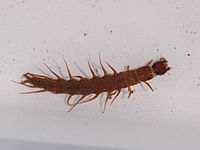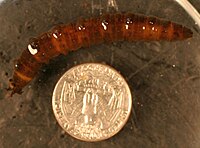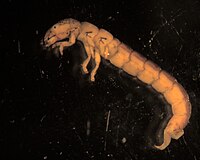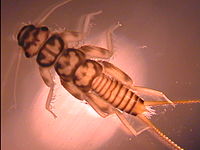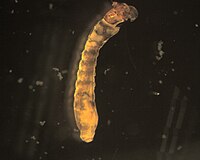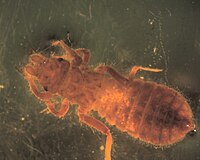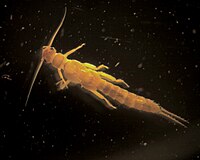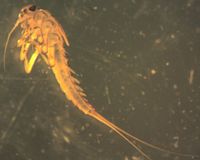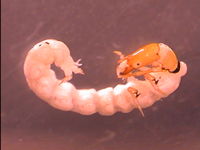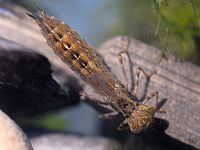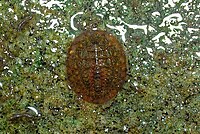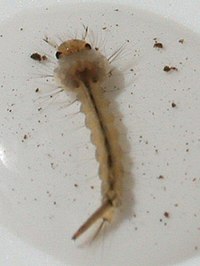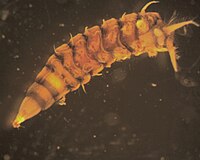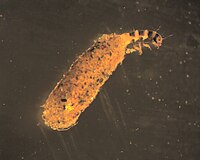Vermont EPSCoR's Streams Project; A Teacher Collaboration on WikiEducator
Openly shared content, practices, and developing resources from Vermont EPSCoR's Streams Project. Join this collaboration and make a difference!
 Lozelle Brook |
|---|
|
| Basin: | Winooski |
| State or Province: | Vermont |
| Country: | USA |
| Latitude: | 44.255821 |
| Longitude: | -72.786359 |
| School: | Harwood Union |
This site was constructed for the nature program at Camp Sunrise. The following are the most common invertebrates collected from this stream site.
Chironomidae
- Order
- Diptera
- Family
- Chironomidae
- Common name
- Nonbiting midge
- Tied fly
- Griffith's Gnat
Midge larvae tend to be the most common macroinvertebrate at our sites. As with other Diptera, there are no true jointed legs. Chironomidae do have a pair of prolegs at each end and preserved individuals tend to curl into a 'C'. Identification past family requires slide-mounted heads. We have seen philopotamid caddisflies misidentified with the chironomids and we suspect that that happens when samples are being sorted from trays. Under a microscope, six prominent legs can be seen on members of the caddisfly family Philopotamidae.
More information on Philopotamidae.
Siphlonuridae
- Order
- Ephemeroptera
- Family
- Siphlonuridae
- Genus
- Siphlonurus
- Common name
- The Gray Drake
- Tied fly
- Gold-ribbed Hare's Ear
This family has gills on all abdominal segments. The labrum does not have a deep notch, and maxillae do not have pectinate spines. They have posterolateral spines on their last abdominal segment.
Click to view the spines on the last abdominal segment, unlike those found in Baetidae.
Pteronarcys
- Order
- Plecoptera
- Family
- Pteronarcyidae
- Genus
- Pteronarcys
- Common name
- The Giant Stonefly
- Tied fly
- Kaufmann's Black Stone
Pteronarcyidae have branching gills from the bases of their legs as does
Perlidae. What distinguishes Pteronarcyidae from Perlidae is the presence of gills on the first two abdominal segments. There are only two genera in this family, but the other,
Pteronarcella, is only found in the west/southwest.
Click to see an example of Perlidae or the gills on the first two abdominal segments.
Corydalidae
- Order
- Megaloptera
- Family
- Corydalidae
- Common name
- Dobsonfly; Hellgrammite
Members of the family
Corydalidae share some superficial commonalities with Trichoptera, but on careful inspection one can see the
two pairs of anal claws that help place it in the order Megaloptera. The size of mature larvae is impressive; specimens from some genera exceed 8 cm in length. The abdominal segments have ribbon-like gills on the lateral portions. The mouth has mandibles that are serrated and used for biting prey. They can be confused with the more slender
whirligig beetle larvae; whirligig larvae also have
simpler jaws.
Nigronia is the genus we most frequently encounter.
Tipulidae
- Order
- Diptera
- Family
- Tipulidae
- Common name
- The Crane Fly
- Tied fly
- Gangle Legs
Like other larvae from the order Diptera, members of the family Tipulidae (crane flies) lack legs. Tipulidae have retracted, difficult-to-see head capsules at one end, and a spiracular disk at the other end. The spiracular disk can sometimes look like a face leading to some confusion about which end is which. Upon gently cutting the head open, one can see that the mandibles are not parallel to each other, but rather move against each other.
The genera we've encountered include Antocha, Dicranota, Hexatoma, Limnophila, Molophilus, Pedecia and Tipula.
Polycentropus
- Order
- Trichoptera
- Family
- Polycentropodidae
- Genus
- Polycentropus
The most common genus we encounter is
Polycentropus. These caseless caddisflies frequently have speckled or freckled heads. The anal proleg typically has a prominent black X, although it can in some specimens appear to be a little faded. They are common at Oakledge Park in Lake Champlain, where we also find an additional genus in the same family:
Nyctiophylax.
Click to see the speckled or freckled heads or the prominent black X.
Hydropsychidae
- Order
- Trichoptera (caddisfly)
- Family
- Hydropsychidae
- Common name
- net spinning caddisfly
- Tied fly
- Emergent Sparkle Pupa, Vermont Hare's Ear
This family of net-spinning caddisflies is very abundant at several sites. They are important filtering collectors and are quite common at urban and agricultural sites where particles of organic material can be important food resources. Genus-level identification is possible for mature specimens and we will include the genera we found at your site if possible.
When using the key, some features that are challenging to see are the forked trochantin and the paired sclerites in the folds between segments. Other, more easily seen key features include filamentous gills on the abdominal segments and the sclerotization of the dorsal surfaces of all three thoracic segments. Keep in mind that with smaller or more immature specimens, genus-level ID may not be possible.
Commonly found genera include Cheumatopsyche, Ceratopsyche, and Hydropsyche. Less commonly, we have found Arctopsyche and Potamyia.
Images of the forked trochantin and the paired sclerites.
Perlidae
- Order
- Plecoptera
- Family
- Perlidae
- Common name
- The Golden Stonefly Creeper
- Tied fly
- Connecticut Curler
This stonefly is characterized by the three pairs of filamentous gills located on the sides of all three thoracic segments. It is distinguished from the family Pteronarcyidae by the absence of gills on the abdominal segments. Often, the thoracic terga are brightly patterned as pictured, though this is not always the case. Another important feature is that the paraglossae and glossae extend different lengths.
Images of filamentous gills and the family Pteronarcyidae.
Genera commonly encountered in this family include Acroneuria, Agnetina, and Paragnetina. Less commonly, we have found Perlesta.
Very rarely encountered genera include Neoperla and Hansonoperla. If you believe you have found either of these, please send a specimen our way!
Simuliidae
- Order
- Diptera
- Family
- Simuliidae
Simuliidae appear rather like bowling pins with heads. Relatively speaking, we collect few members of this family and have we have not identified them past family at this point.
Click here for a close up image of the heads.
Nigronia
- Order
- Megaloptera
- Family
- Corydalidae
- Genus
- Nigronia
Members of the genus
Nigronia share some superficial commonalities with Trichoptera, but on careful inspection one can see the two pair of anal claws that help place it in the order Megaloptera. The size of mature larvae is impressive; specimens from other genera exceed 8 cm in length. The abdominal segments have ribbon-like gills on the lateral portions. The mouth has mandibles that are serrated and used for biting prey. They can be confused with the more slender whirling beetle larvae; whirligig larvae also have simpler jaws.
Images of the two pairs of anal claws, whirligig beetle larvae and their simpler jaws.
Gomphidae
- Order
- Odonata
- Family
- Gomphidae
- Common name
- clubtail dragonflies
Like other Odonata, members of this family have four wingpads. Like members of the sub-order Anisoptera, the abdomen terminates in five points. What distinguishes Gomphidae from Aeshnidae is the fact that Gomphidae has clubbed antennae.
Image of the four wingpads and the abdomen.
More information on Aeshnidae.
Chloroperlidae
- Order
- Plecoptera
- Family
- Chloroperlidae
- Common name
- The Yellow Sally
- Tied fly
- Yellow Sally
Stoneflies from the family Chloroperlidae have cylindrical banded abdomens. When observing their mouthparts, the glossae and paraglossae form a three-pronged (open) notch, and their hind wing pads are parallel (not divergent). Cerci have a vertical fringe of hairs pointing away from the abdomen. Setae on the pronotum are found primarily at the corners.
Baetidae
- Order
- Ephemeroptera
- Family
- Baetidae
- Common name
- Small minnow mayfly
- Tied fly
- Tiny blue-winged olive
This mayfly has either two or three cerci ("tails") and a unique head shape. Its gills are oval shaped and insert dorsally. Commonly encountered genera include
Acerpenna,
Baetis and
Pseudocloeon.
More information on the genera:
Acerpenna
Baetis
Pseudocloeon
Philopotamidae
- Order
- Trichoptera
- Family
- Philopotamidae
- Common name
- fingernet caddisflies
Philopotomidae are net-spinning filtering collectors. A casual observer might sort them with Chironomidae, but a close look reveals six jointed legs. The faint white 'T' shaped labrum extending from the front of the head past the mandibles is diagnostic for the family (it is sometimes withdrawn and hard to see).
Image of the faint white 'T' shaped labrum. Common genera include Dolophilodes, Wormaldia, and Chimarra.
Aeshnidae
- Order
- Odonata
- Family
- Anisoptera
- Common name
- Darner
- Tied fly
- Carey Special
All dragonflies have five points sticking out from the back end. Members of this family of dragonflies are distinctly long as can be seen in the photograph. Other common families tend to be a wider and flatter. If you pull out on the mouthparts under the head you'll see that they look flat in side view. If they look spoon-shaped then it is from a different family. Like other
Odonata, members of this family have four wingpads. Like members of the sub-order
Anisoptera, the abdomen terminates in five points. The prementum and palpal lobes of this dragonfly are flat when viewed from side.
Images of the four wingpads, the abdomen, the prementum and palpal lobes, and a view from the
the side.
Psephenidae
- Order
- Coleoptera
- Family
- Psephenidae
The true "water penny" is commonly found in the waters sampled. Psephenus has a rounded shape with relatively smooth edge. The false water penny, whose edges are serrated, has a more oval appearance. The gills on the ventral surface are found only in the true water pennies.
Culicidae
- Order
- Diptera
- Family
- Culicidae
- Common name
- Mosquito
Mosquito larvae are common at pond sites. As with other Diptera, there are no true jointed legs. Mosquito larvae have a distinctive extension from their rear end that looks and functions like a short, straight snorkel. Because we mostly sample from streams, we rarely sample mosquitoes.
Template:Tabanidae
Athericidae
- Order
- Diptera
- Family
- Athericidae
- Common name
- water snipe flies
Members of the family Athericidae have wrinkled bodies with prolegs on the ventral side. Their mandibles- which can be seen by carefully cutting the head open- move parallel to each other. On the end of their abdomen there are two lobes fringed with setae. Our collections include just the single genus Atherix.
Image of the two lobes of the abdomen.
Hydroptilidae
- Order
- Trichoptera
- Family
- Hydroptilidae
- Common name
- micro caddisflies
Members of this family, commonly called micro-caddisflies are typically found in soft pouch-like cases made of silk. As the common name suggests, they are tiny, but have rather bulbous abdomens. Like the Hydropsychidae, the dorsa all three thoracic segments are sclerotized. Unlike them, however, they have no filamentous gills on their abdomens.
Hydroptila is the most common genus we encounter. A close up image can be seen here and click here for more information onHydropsychidae.




